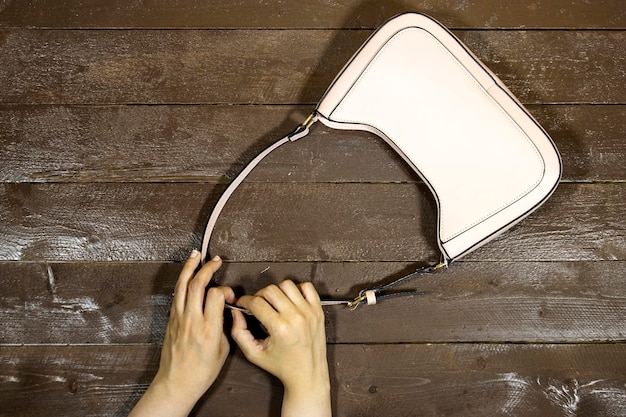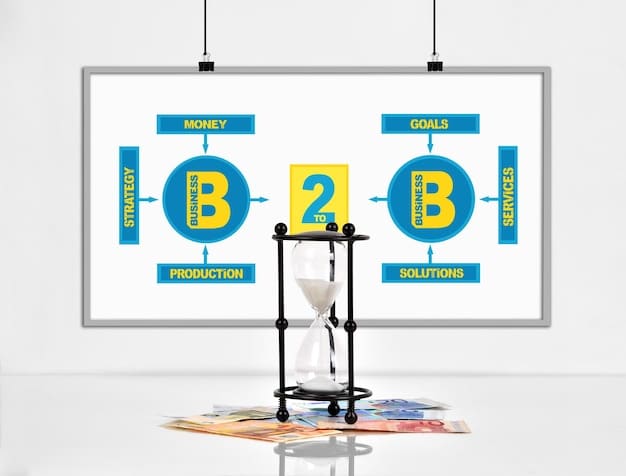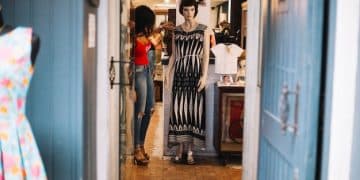The Financial Impact of High-Profile Designer Collaborations (US Market)

The financial impact of collaborating with a high-profile designer in the US market can significantly boost brand visibility, increase sales, and elevate brand perception, but it also requires careful consideration of costs, target audience alignment, and potential risks.
The allure of partnering with a celebrated designer can be a powerful catalyst for growth in the competitive US market. But what exactly is the financial impact of collaborating with a high-profile designer: A US market analysis reveals the multifaceted dimensions of this strategic move.
Understanding the Allure: Why Collaborate with a High-Profile Designer?
Collaborating with a renowned designer isn’t merely a trend; it’s a strategic decision that can significantly impact a brand’s bottom line. These partnerships often generate buzz, attract new customer segments, and inject a dose of exclusivity into otherwise commonplace products.
But what are the specific drivers behind this allure? Let’s delve into the key motivations.
Increased Brand Visibility and Awareness
A prominent designer brings their established reputation and loyal following to the table. This instantly amplifies brand visibility, particularly among the designer’s target demographic.
Enhanced Brand Perception and Prestige
Association with a respected designer elevates a brand’s image, conveying sophistication, creativity, and a commitment to quality. This is especially valuable for brands seeking to reposition themselves in the market.
- Attract New Customer Segments: Designer collaborations can tap into previously inaccessible markets, expanding the brand’s reach.
- Drive Sales and Revenue Growth: The limited-edition nature of these collaborations often creates a sense of urgency, driving sales and boosting revenue.
- Create Media Buzz and Social Media Engagement: Such partnerships naturally generate significant media coverage and social media chatter, further amplifying brand awareness.
In essence, collaborating with a renowned designer is a strategic investment that can yield substantial returns in terms of brand equity and financial performance.

The Financial Investment: What’s the Cost of Collaboration?
While the potential benefits of collaborating with a high-profile designer are undeniable, it’s crucial to understand the associated costs. These collaborations require significant financial investment. Understanding where the money goes is essential.
Here’s a breakdown of the key expense categories:
Designer Fees and Royalties
Designers command significant fees for their expertise and creative input. Royalties, based on a percentage of sales, are also typically part of the agreement.
Marketing and Advertising Expenses
A successful collaboration requires a robust marketing campaign to generate maximum awareness and excitement. This includes digital advertising, public relations, and influencer marketing.
- Production Costs: Depending on the product category, production costs can be substantial, particularly if high-quality materials or specialized manufacturing processes are involved.
- Legal and Contractual Fees: Negotiating and finalizing a collaboration agreement requires legal expertise, incurring attorney fees and related expenses.
- Risk Mitigation Costs: Protecting intellectual property and mitigating potential risks associated with the collaboration requires proactive measures and associated costs.
It’s essential to conduct a thorough cost-benefit analysis before embarking on a designer collaboration to ensure that the potential returns justify the financial investment.
Measuring the ROI: Key Performance Indicators (KPIs) for Success
Quantifying the return on investment (ROI) of a designer collaboration is crucial for evaluating its effectiveness and informing future strategic decisions. This requires tracking specific key performance indicators (KPIs).
Here’s a selection of essential KPIs to monitor:
Sales Revenue and Profit Margin
Track the incremental sales revenue generated by the collaboration, as well as the profit margin on the collaborative products. This provides a direct measure of financial performance.
Brand Awareness and Media Mentions
Monitor brand mentions in traditional media and social media, as well as website traffic and search engine rankings. This assesses the impact on brand visibility.
- Customer Acquisition Cost (CAC): Calculate the cost of acquiring new customers through the collaboration. Comparing this to the CAC for other marketing channels reveals the efficiency of the partnership.
- Customer Lifetime Value (CLTV): Assess whether the collaboration attracts customers with a higher CLTV than average. This reflects the long-term impact on customer loyalty and spending.
- Social Media Engagement: Track metrics such as likes, shares, comments, and mentions related to the collaboration. This measures the level of engagement and virality generated.
By diligently tracking these KPIs, brands can gain valuable insights into the financial impact of their designer collaborations and optimize their strategies for maximum ROI.

Case Studies: Successes and Failures in the US Market
Analyzing real-world examples of designer collaborations in the US market provides invaluable lessons for brands considering this strategic approach. Both successes and failures offer crucial insights.
Let’s examine a few notable case studies:
The Success Story: Target and Missoni
Target’s long-standing collaboration with Missoni is widely regarded as a benchmark for successful designer partnerships. The collection generated phenomenal sales, drove significant brand awareness, and cemented Target’s reputation for affordable style.
The Cautionary Tale: H&M and Versace
While H&M’s collaborations are generally successful, the Versace partnership faced some criticism. Some felt that the collection didn’t fully capture the essence of the Versace brand, potentially diluting its prestige.
- The Innovation Driver: Nike and Off-White: Marked by innovative designs and strong branding, this partnership resonates deeply with a younger demographic.
- The Luxury Reinforcer: Louis Vuitton and Supreme: The collaboration enhanced brand visibility and prestige through clever marketing.
- The Unexpected Hit: Uniqlo and J.W. Anderson: A mainstream hit that was relatively affordable, boosted brand awareness and drove sales.
These case studies highlight the importance of careful designer selection, clear brand alignment, and effective marketing in achieving a successful and financially rewarding collaboration.
Mitigating Risks: Protecting Your Investment
Collaborating with a high-profile designer inherently involves certain risks. Protecting your investment requires proactive measures to mitigate potential downsides.
Here are some key risk mitigation strategies:
Thorough Due Diligence
Before entering into an agreement, conduct thorough due diligence on the designer’s reputation, past performance, and potential conflicts of interest. Investigate everything.
Robust Contractual Agreements
Establish clear contractual agreements that address issues such as intellectual property ownership, usage rights, termination clauses, and dispute resolution mechanisms. Protect your assets.
- Insurance Coverage: Secure adequate insurance coverage to protect against potential liabilities arising from the collaboration.
- Contingency Planning: Develop contingency plans to address potential challenges, such as production delays, quality control issues, or negative publicity.
- Brand Monitoring: Continuously monitor brand perception and customer sentiment throughout the collaboration to identify and address potential issues promptly.
By implementing these risk mitigation strategies, companies can safeguard their investment and maximize the chances of a successful and financially rewarding designer collaboration.
Future Trends: The Evolving Landscape of Designer Collaborations
The landscape of designer collaborations is constantly evolving, driven by technological advancements, changing consumer preferences, and emerging market trends. Looking ahead, several key trends are poised to shape the future of these partnerships.
These trends include:
Increased Focus on Sustainability and Ethical Practices
Consumers are increasingly demanding sustainable and ethically sourced products. Future designer collaborations will likely prioritize these values, aligning with consumer expectations.
Greater Emphasis on Digital Engagement and Virtual Experiences
Digital channels and virtual experiences will play an increasingly important role in designer collaborations, enabling brands to reach wider audiences and create more immersive experiences.
- Personalization and Customization: Designer collaborations will increasingly offer personalized and customized products, catering to individual customer preferences.
- Data-Driven Insights: Brands will leverage data analytics to gain deeper insights into customer behavior and preferences, informing designer selection and product development decisions.
- Long-Term Partnerships: Companies may develop deeper, more long-term partnerships with designers rather than one-off collaborations.
By staying abreast of these evolving trends, brands can position themselves at the forefront of the designer collaboration landscape and capitalize on emerging opportunities.
| Key Aspect | Brief Description |
|---|---|
| 🚀 Brand Visibility | Designer collaborations boost brand exposure and reach new customers. |
| 💰 Financial Investment | Requires significant investments in fees, marketing, and production. |
| 📈 ROI Measurement | Track sales, brand awareness, and customer acquisition to assess ROI. |
| 🛡️ Risk Mitigation | Conduct due diligence, draft robust contracts, and monitor brand perception. |
Frequently Asked Questions
▼
Partnering with a reputed designer can significantly boost brand visibility, attract new customer segments, enhance brand image, and drive sales through limited-edition collections.
▼
US companies should anticipate costs related to designer fees, royalty payments, marketing and advertising campaigns, production expenses, legal fees, and risk mitigation measures for intellectual property.
▼
Businesses can measure ROI by tracking metrics like sales revenue, profit margins, brand awareness (media mentions), customer acquisition costs, and the customer lifetime value to determine success.
▼
Successfulexamples include Target’s collaboration with Missoni. Cautionary tales include H&M’s Versace partnership due to diluted brand essence, offering key lessons on brand alignment.
▼
Mitigation strategies involve conducting thorough due diligence on the designer, establishing robust contractual agreements, securing insurance coverage, and carefully monitoring brand perception throughout the partnership.
Conclusion
In conclusion, navigating the financial intricacies of collaborating with a high-profile designer in the US market requires a balanced approach. While these collaborations can unlock substantial financial and brand-building opportunities, achieving success demands careful planning, diligent execution, and a keen awareness of potential risks and evolving market trends.





